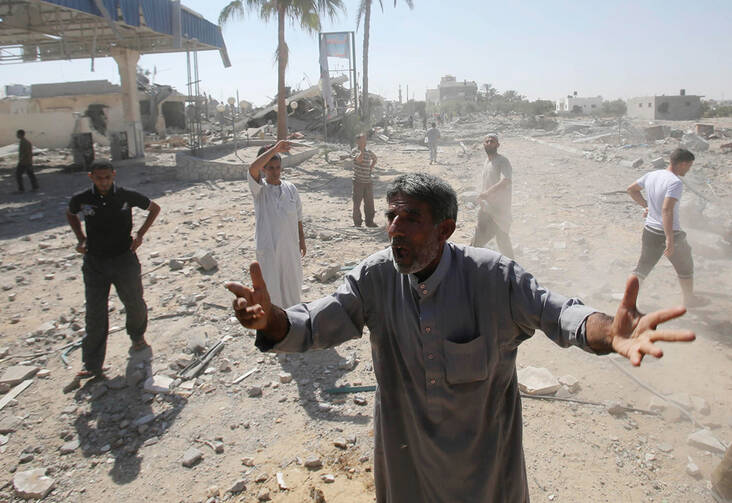Israeli forces began withdrawing from parts of the Gaza Strip on Aug. 3, after a quick collapse of a humanitarian ceasefire on Aug. 1 and a ferocious bombardment of the border community of Rafah in its aftermath. As what he described as a redeployment of Israeli forces began, Prime Minister Benjamin Netenyahu said the Israeli Defense Forces would continue operations in Gaza, taking “as much time as necessary” and exerting “as much force as needed.”
The overall death toll by Aug. 4 included more than 1,800 Palestinians. At least 69 percent of the dead in Gaza are civilians, according to U.N. sources, including more than 350 children. On the Israeli side, 64 Israeli soldiers and three civilians have been killed in the conflict.
Looking beyond the current violence with any degree of hope seems at best naïve. The images of the wounded and dying emerging from the conflict “are horrific,” says Atalia Omer, an associate professor at the Kroc Institute for International Peace Studies at the University of Notre Dame in South Bend, Ind. Still, “we can’t give in to despair,” Omer says. “We can never reach that point.”
For long-term peace to be achieved, “the solution is not military,” she says simply. “The solution is diplomatic and political.”
Despite political and media fixation on “terror tunnels,” Israel’s right to self-defense and even the immediate flashpoint of the most recent violence, the murder of three Israeli teens on the West Bank, the ultimate source of tension, Omer says, “remains the occupation.”
She explains, “If you crush Hamas, something else will only emerge because Palestinian people are still living under occupation.”
As an Israeli viewing the carnage from the United States, Omer notes the emerging voices for peace and social justice in Israel, especially among its young people. The resilience of Israeli civil society’s actors for peace has been impressive, she suggests, as tolerance for dissent and cultural critique within Israel has diminished in recent years and fallen especially rapidly since the beginning of I.D.F. operations in Gaza on July 8.
She admits that pessimists are probably justified in thinking there is little reason to expect a change in the political “narrative of inevitability” in Israel any time soon. That narrative compels an inverted reality, she suggests, where the dominant, occupying force pronounces its own victimhood while simultaneously defining Palestinians as terrorists who “have a culture of death,” and use the deaths of their babies to win public relations points. Such intense and widely held beliefs dehumanize Palestinians, she says, and enable Israelis to distance themselves from the suffering.
“Most of Israeli society accepts this inevitability,” Omer says. “They’ll say, ‘It’s sad; we don’t want to kill babies, but we have no choice.’”
Important global pressure for change, she says, comes from civil society agents like, in the United States, the Jewish Voice for Peace. Within the political establishment in Israel, the Meretz Party remains committed to peacemaking. What a political earthquake, she muses, if the tireless U.S. Secretary of State John Kerry were to consult with Meretz leaders the next time he lands in Israel instead of dutifully visiting with Likud leaders. “That would be a very bold, creative move, but I don’t know if [the Obama administration has] the courage or the political capital to do that.”
Omer insists that the existence of Meretz and other persistent actors for peace in Israeli civil society—Breaking the Silence, an organization of I.D.F. veterans who testify to the reality of the occupation; Combatants for Peace, a joint campaign by Palestinians and Israelis; and the Coalition of Women for Peace, a feminist organization against the occupation of Palestine and for a just peace—should be a source of hope that a peaceful resolution to the conflict between Israelis and Palestinians remains possible.
“It is often said that Israel has a right to defend itself,” she says, “but Gaza is not a sovereign state; it is occupied.” She adds, “Israel controls everything, so most of the responsibility for changing the course of events will have to reside with Israel. But Hamas will have to demonstrate political will [for a ceasefire]; it will have to stop firing rockets; it will have to demonstrate it is in control of its people.”








